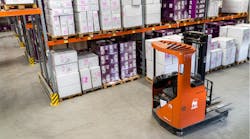Inventory management for manufacturers can be tricky, especially since there are so many fluctuating factors, and some that are outside a company’s direct control. However, by skillfully using proven inventory management tips, people can save money while enjoying better oversight over their resources.
1. Perform a Supply Chain Audit
Careful scrutinization of the supply chain can show manufacturers what’s working well and where they need to improve. Doing an audit correctly means looking at the supply chain from beginning to end and seeing how it all works together. This approach is an excellent way to reduce waste, which can lead to measurable savings.
It’s also useful to listen to customer feedback. People will appreciate being listened to, and customers are also often great sources of information that would otherwise get overlooked.
Any bottlenecks can potentially cause climbing costs if left unresolved. The audit could reveal inefficiencies—e.g., it costs more than it should to get specific raw materials from a particular supplier. People might save money in such cases by changing suppliers or investigating getting a bulk discount from the current one.
2. Use the A-B-C Method of Inventory Management for Manufacturers
Many manufacturers end up wasting money by having too many slow-selling products on hand and not enough of the items customers want most. However, many inventory management tips give advice for avoiding such scenarios. One of them concerns the A-B-C Method.
A commonly cited statistic is that 70-80% of a company’s annual consumption value comes from only about 10-20% of all its inventory. This method works well with that takeaway because it encourages manufacturers to become more familiar with the items that are most likely to generate the highest overall profits.
This three-tier system places the highest-consumption-value items in Category A. Then, the items in Category B comprise approximately 30% of all inventory and 15-20% of the annual consumption value. Finally, the goods in Category C account for less than 5% of the annual consumption value and about 50% of the total inventory.
Once manufacturers put all pieces of inventory in the right categories, they’re in an excellent position to assess which ones generate the most profits. Deprioritizing those that are less profitable can help companies save money by focusing on sourcing the inventory that’s most likely to bring meaningful payoffs.
3. Use a Real-Time Inventory Alerts System
Manufacturers can only know about inventory-related problems if they have reliable and data-driven systems in place. One practical way to utilize data is to implement inventory alerts. People can then become proactive rather than reactive. If that happens, they will have the knowledge needed to identify money-saving options and respond in time to situations that could cost or waste financial resources if left unchecked.
For example, setting low-stock alerts could prevent people from needing to pay for rush shipping if in-demand items sell out before they can react. Alternatively, systems can recognize large orders and inform inventory managers when they happen. Those leaders may then realize the larger orders happen so often that it makes good financial sense to negotiate bulk-order pricing with the supplier to save money.
Slow-selling items could also have corresponding inventory alerts. Manufacturers might then direct authorized retailers to launch limited-time sales, buy-one-get-one-free offers or other incentives that stimulate sales. A lack of awareness can prove costly for manufacturers because it could give them the false impression that they’re consistently profitable. When profits decrease, real-time data provides the information that lets leaders make confident decisions and get the company back on track.
4. Take Inventory Management Tips From Other Sectors
Inventory management for manufacturers is an often-discussed topic. Still, those trying to learn how to improve their methods may find some of the best suggestions come from sectors other than manufacturing. Many ideas originating elsewhere are easy to adapt to the industry because they rely on well-respected best practices.
Consider a case where the U.S. Army recycled more than 15 tons of expired documents in Europe. However, that purposeful purge resulted in nearly 1,000 wooden pallets used to hold the paperwork. Military leaders responded by finding a way to repurpose them by integrating them back into the supply chain. This creative approach saved more than €27,000.
This option benefited everyone involved, too. First, those who originally received the pallets did not need to pay for their disposal. Then, the organization that got them from the recipient used them to transfer semi-perishable goods to commissaries in numerous European destinations and could do that without buying more pallets to hold the products.
5. Explore 3D Printing for Spare Parts
Even the best efforts to manage inventory can quickly go awry if it takes too long to get essential components. An increasing number of manufacturers deal with that reality the best they can by using on-site 3D printers to make spare parts on demand. Even if the 3D printer comes with a relatively high upfront cost, it should quickly pay for itself, provided the manufacturer uses it frequently enough.
Coverage from Deloitte indicated printing parts could lower costs, while bringing other benefits. Relatedly, the COVID-19 pandemic proved a driving force in getting more companies interested in printing parts rather than sourcing them through other means. Indeed, the health crisis necessitated new methods of inventory management for manufacturers because it caused so much disruption.
3D printing is also an option for highly specialized or significantly in-demand products. When manufacturers can create the parts they need in-house, their supply chain dependencies lower, allowing companies to operate more nimbly. 3D printing can create items in minutes to hours, depending on their size and complexity. Such timeframes are often much shorter than those associated with ordering and shipping.
6. Make a Supply Chain Management Plan and Update It Regularly
Inventory management for manufacturers is a complex and ever-changing process. People must stay aware of factors within and outside their organizations that could make it easier or more challenging to source certain items. They have to study aspects like changing prices and volatile economic conditions that could make a difference in their operations, too.
These are all good reasons for people to consider implementing all the inventory management tips they learn into a formal, carefully documented plan. It should include matters such as inventory management technologies, employee training and which suppliers are best positioned to meet specific needs.
The management plan must also remain as relevant as possible by getting detailed updates as necessary. Those could occur when a company expands, hires new team members or makes major process changes.
The plan should also contain key performance indicators (KPIs). Those are essential for showing manufacturers whether they’re moving in the right direction with saving money or making any other progress. Choosing metrics to track is an easy and effective way to keep everyone focused and aware of what they need to achieve within the organization.
Saving Money is an Ongoing Concern
Keeping costs reasonable is one of the primary parts of inventory management for manufacturers. Successful efforts to reduce expenses free up more of the budget for activities that promote growth and cause a competitive advantage.
Even if the bottom line looks good now, the circumstances might not stay that way forever. That’s why the money-saving inventory management tips here are widely applicable to manufacturers of all types and sizes.









